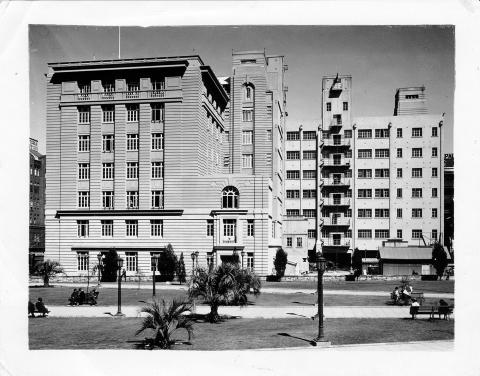
- News of the day
-
The Evening News, Monday 3rd April 1933
Light Wanted
Post Office Disabilities
Mt Morgan, Monday:
A common sight to be witnessed any dark night at the Mt. Morgan Post Office, is that of persons flashing hurricane lamps and striking matches trying to locate the place where letters and newspapers can be posted.
The person posting a letter has to go up a flight of concrete steps and when he gets to the posting recess he finds it in inky darkness. There is a gas lamp inside the vestibule, but it has not been lit for years, evidently on the score of economy. Now that the town is on the upgrade it is up to the P.M. General’s Department to have this lamp lighted for a few hours at night. It will add to the convenience of customers, and may prevent an accident.
- Background
-
The Mount Morgan Post Office is an example of the Federation Arts and Crafts style in the detailing with piers extending above the roof line and the use of stucco to provide a contrast for decorative elements. It is a rare example of a post office in Queensland built in brick and is also rare as an example of this style. It is an excellent example of the later work of the office of the State Government Architects during the time of A B Brady and T Pye. As a record of the past economic importance of Mount Morgan it is one of the fine public buildings in the town.
The building is an example of the Arts and Crafts style in the detailing with the use of contrasting materials and the extension of piers above the roof line. It is a rare example of this style in Queensland and also rare in the use of brick instead of timber. There are only five examples of brick post offices, one of which in Cairns has been demolished. The others are Ipswich (1900), Stanthorpe (1901), and Woollongabba (1904). Both this post office and Stanthorpe were designed by the Government Architect A B Barry. All these brick post offices are categorised as Federation type and bear other similarities in style and details with stucco trim and sash windows with small panes in the upper sash (Walker, 1983). The plan of this Post Office with double porches surrounding a central public postal hall is similar to a more common timber version with fourteen out of the original seventeen identified in Meredith Walker's study surviving. Other similar characteristics are the hipped and vented roof and eaves. This double porch type was favoured by Thomas Pye whilst Deputy Government Architect in the southern regions of Queensland with example such as Esk, Clifton and Pittsworth.
Courtesy of the Australian Heritage Database
/150.386928,-23.6455036,7/450x450@2x.png?access_token=pk.eyJ1IjoicXNhLWRpc2NvLXFsZCIsImEiOiJjamJmdTgyZXEyeWNjMnlxZm8xcmtieHgxIn0.lmT9J5tTPKGuuccQgCVSAg)



